
Yuba City is a city in Northern California and the county seat of Sutter County, California, United States. The population was 70,117 at the 2020 census. Yuba City is the principal city of the Yuba City Metropolitan Statistical Area which encompasses all of Sutter County and Yuba County. The metro area's population is 164,138. It is the 21st largest metropolitan area in California, ranked behind Redding and Chico. Its metropolitan statistical area is part of the Greater Sacramento CSA.

The Sikh Gurdwara of San Jose is a gurdwara located in the Evergreen district of San Jose, California. It was founded in 1984 by leaders of the then-rapidly growing community of Sikhs in the area. It is the largest Gurdwara in the world outside of India.
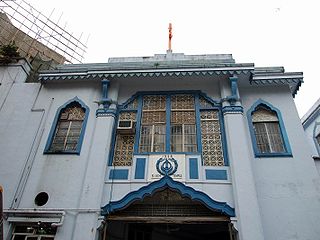
Khalsa Diwan Sikh Temple, originally known as Sri Guru Singh Sabha, is a Gurdwara in the Wan Chai District of Hong Kong, on the junction of Queen's Road East and Stubbs Road, Hong Kong Island. It was re-opened on 8 September 2022 by Hong Kong SAR Chief Executive, John Lee Ka-chiu, after a 5 year renovation project.

Anandpur Sahib, also referred simply as Anandpur, is a city in Rupnagar district (Ropar), on the edge of Shivalik Hills, in the Indian state of Punjab. Located near the Sutlej River, the city is one of the most sacred religious places in Sikhism, being the place where the last two Sikh Gurus, Guru Tegh Bahadur and Guru Gobind Singh, lived. It is also the place where Guru Gobind Singh founded the Khalsa Panth in 1699. The city is home to Takhat Sri Kesgarh Sahib, the third of the five Takhts in Sikhism.
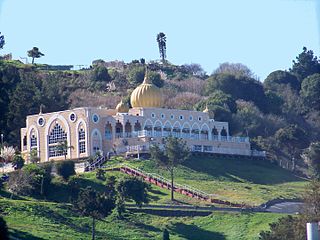
The Sikh Center of San Francisco Bay Area is a Sikh gurdwara in the hills of unincorporated El Sobrante, California, in the East Bay of the San Francisco Bay Area.
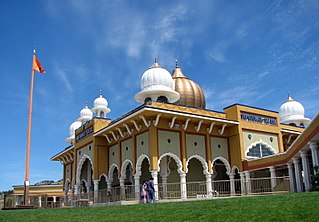
American Sikhs form the country's sixth-largest religious group. While the U.S. Census does not ask about religion, 70,697 Americans declared Sikh as their ethnicity in the 2020 census. The U.S. Census Bureau cites the 2008 American Religious Identification Survey's estimate of the adult Sikh American population at 78,000. The Pew Research Center estimated the Sikh American adult population to be 140,000 and the total population at 200,000 in 2012 while the World Religion Database at Boston University estimated the American Sikh population to be at 280,000 in 2012. Sikh organizations like the Sikh Coalition and American Sikh Congressional Caucus estimate the Sikh American population to be as high as 1,000,000, but do not provide any sources for these figures; 500,000 nevertheless remains the most cited Sikh American population size. With 1% of Asian Americans being Sikh, and 90.7% of Sikh Americans being Asian American, the American Sikh population can be estimated at around 200,000–300,000 in 2021. The largest Sikh populations in the U.S. are found in California (52%), New York (11%), and Washington (6%).

Sikhism is the fourth-largest religious group in Canada, with nearly 800,000 adherents, or 2.1% of Canada's population, as of 2021. The largest Sikh populations in Canada are found in Ontario, followed by British Columbia and Alberta. As of the 2021 Census, more than half of Canada's Sikhs can be found in one of four cities: Brampton (163,260), Surrey (154,415), Calgary (49,465), and Edmonton (41,385).
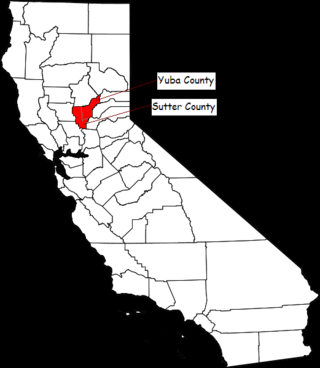
The Yuba–Sutter area, or Yuba City Metropolitan Statistical Area, is a smaller metropolitan community including Yuba and Sutter Counties in Northern California's Central Valley within the Greater Sacramento area.

The Khalsa Diwan Society Vancouver is a Sikh gurdwara organization in Vancouver, British Columbia, Canada.
The Ramdasia were historically a Sikh, Hindu sub-group that originated from the caste of leather tanners and shoemakers known as Chamar.

Punjabi Americans are Americans whose ancestry originates wholly or partly from the Punjab region of India and Pakistan. There are over 300,000 Punjabi Americans, many of whom were Sikhs, Ravidassias from British Punjab who first settled in California's Central Valley.
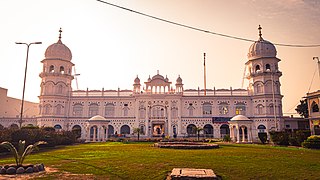
Gurdwara Janam Asthan, also referred to as Gurdwara Nankana Sahib, is a highly revered gurdwara that is situated at the site where the founder of Sikhism, Guru Nanak, was born. The shrine is located in Nankana Sahib, Punjab, Pakistan.

The Golden Temple (also known as the Harmandir Sahib, or the Darbār Sahib, is a gurdwara located in the city of Amritsar, Punjab, India. It is the pre-eminent spiritual site of Sikhism. It is one of the holiest sites in Sikhism, alongside the Gurdwara Darbar Sahib Kartarpur in Kartarpur, and Gurdwara Janam Asthan in Nankana Sahib.

Sikhism in the United Arab Emirates has a following of over 50,000; the majority of Sikhs in the UAE can be found in Dubai, Abu Dhabi or Sharjah.

Sikhism in Indonesia is a small religious minority in Indonesia. There are about 10,000 to 15,000 Sikhs in Indonesia.

A Ragi is a Sikh musician who plays hymns (shabads) in different ragas as prescribed in the Sri Guru Granth Sahib.
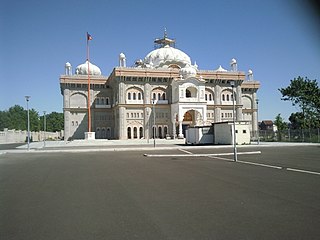
The Guru Nanak Darbar Gurdwara is a Sikh Gurdwara situated in the town of Gravesend, Kent. It is the largest Gurdwara in Europe and also one of the largest outside India.

The South Asian community in British Columbia was first established in 1897. The first immigrants originated from Punjab, British India, a northern region and state in modern-day India and Pakistan. Punjabis originally settled in rural British Columbia at the turn of the twentieth century, working in the forestry and agricultural industries.

Sikhism in Greater Vancouver is one of the main religions across the region, especially among the Indo-Canadian population. The Sikh community in Vancouver is the oldest, largest and most influential across Canada, having begun in the late 19th century.

Sikhism in South Korea is a minority religion.


















